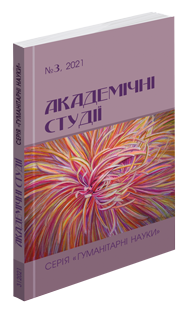Abstract
In the modern world cinema is the main key to new ideas and trends, which makes it a unique socio-cultural phenomenon that attracts attention of many scholars and linguists in particular. Semiotic, linguistic, cultural and cognitive features of film discourse are frequently studied. Film discourse has a multimodal nature, as it combines a number of verbal, nonverbal and paraverbal aspects. Although a film is always based on a script (film text), its implementation is only possible with the help of audio-visual components. Due to its complexity, the concept of film discourse has not been clearly defined yet. The article analyzes the main approaches to defining the concept of film discourse, as well as outlines the problem of distinguishing between the concepts of “film text” and “film discourse”. The paper contains a brief review of recent studies of film discourse and provides the classification of film discourse types according to various criteria, namely: the form of message transmission, the number of participants in the film dialogue, the recipient of the message, compliance with the principle of cooperation, and genre. Film discourse combines the features of monologue and dialogic speech, it can reflect communication on both personal and social levels, it also represents the elements of cooperative and confrontational interaction. In addition, film genre plays a vital role, as there are fiction and documentary film texts which, correspondingly, present a huge difference in stylistics and use of verbal and non-verbal means. The paper also highlights the characteristics of film discourse. In particular, attention is focused on the category of integrity and completeness in cinematography, specifics of cinematic tools (editing, music, sound effects, tempo, facial expressions, gestures, actors’ speech, shot composition, combination of color and graphic effects), combination of verbal and nonverbal components, extralinguistic factors, as well as the factors of anthropocentrism and intertextuality. Finally, the article summarizes the ways in which all the mentioned factors are combined.
References
Бенвенист Э. Общая лингвистика : пер.с франц. Москва : Прогресс, 1975. 447 c.
Горюнова Н. Л. Художественно-выразительные средства экрана. Ч. I. Пластическая выразительность кадра. Москва : Изд-во Ин-та повышения квалификации работников телевидения и радиовещания, 2000. 41 с.
Зарецкая А. Н. Особенности реализации подтекста в кинодискурсе. Вестн. Челябин. гос. ун-та. 2008. № 16. С. 70–74.
Звєрєва О. Г. Сучасний кінодискурс: специфіка та особливості категоріального потенціалу. Наукові записки. Серія: Право, економіка, гуманітарні науки. Харків, 2006. Вип. 1. С. 111–115.
Карасик В. И. Языковой круг: личность, концепты, дискурс. Волгоград : Перемена, 2004. 477 с.
Котова І. А. Кінодискурс: еволюція об’єкта і підхід дослідження. Наукові праці Кам’янець-Подільського національного університету імені Івана Огієнка. Серія: Філологічні науки. Кам’янець-Подільський, 2012. Вип. 29(2). С. 200–203.
Крисанова Т. А. Актуалізація негативних емоцій в англомовному кінодискурсі: когнітивно-комунікативний і семіотичний аспекти : дис. канд. д-ра філол. наук : 10.02.04. Харків, 2020. 514 с.
Лаврiненко І. М. Стратегії і тактики зміни комунікативних ролей у сучасному англомовному кінодискурсі : автореф. дис. … канд. філол. наук : 10.02.04. Харків, 2011. 21 с.
Лотман Ю. М., Цивьян Ю. Г. Диалог с экраном. Таллин : Александра, 1994. 215 c.
Макаревич О. О. Кінодискурс як середовище реалізації реактивних мовленнєвих актів. Матеріали міжвузівської наукової Інтернет-конференції «Текст і дискурс: когнітивно-комунікативні перспективи». Кам’янецьПодільський національний університет імені Івана Огієнка. 2017. С. 93–100.
Селиванова Е. А. Основы лингвистической теории текста и коммуникации. Киев : Фитоссоциоцентр, 2002. 336 с.
Слышкин Г. Г., Ефремова М. А. Кинотекст (опыт лингвокультурологического анализа). Москва : Водолей Publishers, 2004. 153 c. 9.
Сорокин Ю. А., Тарасов Е. Ф. Креолизованные тексты и их коммуникативная функція. Оптимизация речевого воздействия. Москва, 1990. С. 180–186.
Фуко М. Слова и вещи. Археология гуманитарных наук. Санкт-петербург : А–cad, 1994. 405 с.
Harris Z. Discourse analysis. Language. 1952. Vol. 28. No 1. P. 1–30. 103.
Kozloff S. Overhearing Film Dialogue. Berkeley, Los Angeles : University of California Press, 2000. 323 р.
Stam R. Film Theory: An Introduction. Oxford : Blackwell Publishers, 2000. 392 p.

